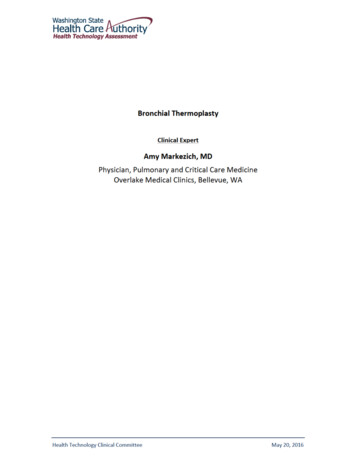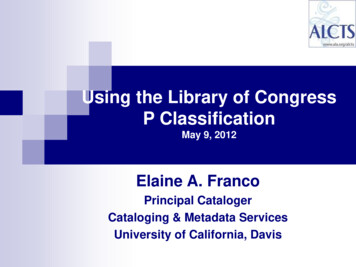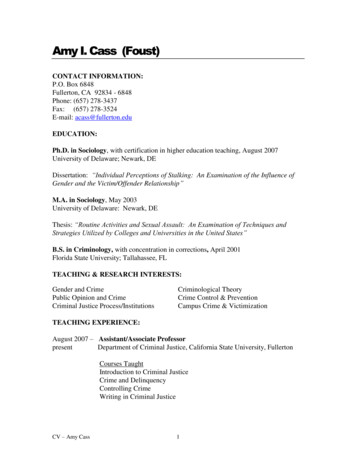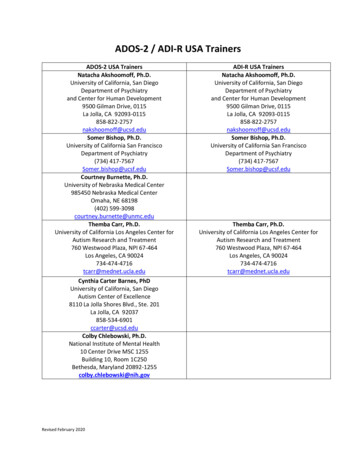
Transcription
Amy Markezich, M.D.Overlake Medical Clinics1231-116th Ave NE, Suite 400Bellevue, WA 98004-4623Amy.markezich@overlakehospital.org(425) 454-2671Positions2012-presentPhysician, Pulmonary and Critical Care Medicine,Overlake Medical Clinics, Bellevue, WA2012-2015Associate Medical Director, Pulmonary Clinic, OverlakeMedical Clinics, Bellevue, WA2009-2012Physician, Pulmonary and Critical Care Medicine,Overlake Internal Medicine Associates, Bellevue, WAEducation7/2005 – 7/2009Harvard Fellowship Program in Pulmonary and CriticalCare Medicine – Fellowship7/2004 - 6/2005Brigham and Women’s Hospital Internal MedicineResidency Program – Residency6/2002 - 6/2004Stanford Medical Center Internal Medicine ResidencyProgram – Internship and Residency9/1997 – 6/2002Stanford University School of MedicineM.D. – 20029/1993 - 4/1997Stanford University – Psychology with Distinction, andBiological SciencesB.A., B.S. – 1997Academic Honors1998, 1999Recipient of Stanford Medical Scholars Research Fellowship1996-1999Excellence in Teaching Award, Department of Biological Sciences, StanfordUniversity1996-1997Psi Chi National Psychology Honor Society1994-1997Academic All-American, National Collegiate Athletics Association1994-1996Scholar Athlete, Stanford University Athletics
Amy Markezich, M.D.Research Experience2010-2012Site Principle Investigator, AEGIS Study Group, AEGIS Clinical TrialResearch Subject: Prospective evaluation of a bronchial airway geneexpression classifier for the detection of lung cancer.2007-2009Research Fellow, Division of Pulmonary and Critical Care Medicine, Brighamand Women’s Hospital, Harvard Medical SchoolSupervisor: Dr. Elliot Israel, MD, Associate Professor of MedicineResearch Subject: The effect of long-acting beta agonists versus long-actinganticholinergics on asthma exacerbations in patients with specific singlenucleotide polymorphisms of the beta-2 adrenergic receptor.1998-2000Medical Scholars Fellow, Division of Vascular Surgery, Stanford UniversitySchool of MedicineSupervisor: Dr. Ronald Dalman, MD, Associate Professor of SurgeryResearch Subject: The role of matrix metaloproteinases in flow-mediatedarterial enlargement.1996-1997Research Assistant, Division of Transplant Surgery, Stanford UniversitySchool of MedicineSupervisor: Dr. Edward Alfrey, MD, Assistant Professor of SurgeryResearch Subject: Determination of when to perform a single vs. dualcadaveric kidney transplant with expanded criteria donor kidneys.p. 2
Amy Markezich, M.D.Publications1.Silvestri GA, Vachani A, Whitney D, Elashoff M, Porta Smith K, Ferguson JS, Parsons E, Mitra N,Brody J, Lenburg ME, Spira A; AEGIS Study Team. A bronchial genomic classifier for thediagnostic evaluation of lung cancer. N Engl J Med. 2015 Jul 16;373(3):243-51.2.Israel E, Lasky-Su J, Markezich A, Damask A, Szefler SJ, Schuemann B, Klanderman B, Sylvia J,Kazani S, Wu R, Martinez F, Boushey HA, Chinchilli VM, Mauger D, Weiss ST, Tantisira KG;SHARP Investigators. Genome-wide association study of short-acting beta2-agonists. A novelgenome-wide significant locus on chromosome 2 near ASB3. Am J Respir Crit Care Med. 2015 Mar1;191(5):530-7.3.Himes BE, Jiang X, Hu R, Wu AC, Lasky-Su JA, Klanderman BJ, Ziniti J, Senter-Sylvia J, Lima JJ,Irvin CG, Peters SP, Meyers DA, Bleecker ER, Kubo M, Tamari M, Nakamura Y, Szefler SJ,Lemanske RF Jr, Zeiger RS, Strunk RC, Martinez FD, Hanrahan JP, Koppelman GH, Postma DS,Nieuwenhuis MA, Vonk JM, Panettieri RA Jr, Markezich A, Israel E, Carey VJ, Tantisira KG,Litonjua AA, Lu Q, Weiss ST. Genome-wide association analysis in asthma subjects identifiesSPATS2L as a novel bronchodilator response gene. PLos Genet. 2012 Jul;8(7):e10028244.Tantisira KG, Damask A, Szefler SJ, Schuemann B, Markezich A, Su J, Klanderman B, Sylvia J,Wu R, Martinez F, Boushey HA, Chinchilli VM, Mauger D, Weiss ST, Israel E; SHARPInvestigators. Genome-wide association identifies the T gene as a novel asthma pharmacogeneticlocus. Am J Respir Crit Care Med. 2012 Jun 15;185(12):1286-915.Wechsler ME, Kunselman SJ, Chinchilli VM, Bleecker E, Boushey HA, Calhoun WJ, Ameredes BT,Castro M, Craig TJ, Denlinger L, Fahy JV, Jarjour N, Kazani S, Kim S, Kraft M, Lazarus SC,Lemanske RF Jr, Markezich A, Martin RJ, Permaul P, Peters SP, Ramsdell J, Sorkness CA,Sutherland ER, Szefler SJ, Walter MJ, Wasserman SI, Israel E; National Heart, Lung and BloodInstitute's Asthma Clinical Research Network. Effect of beta2-adrenergic receptor polymorphism onresponse to longacting beta2 agonist in asthma (LARGE trial): a genotype-stratified, randomized,placebo-controlled, crossover trial. Lancet. 2009 Nov 21;374(9703):1754-646.Markezich, A. European Respiratory Society/American Thoracic Society Asthma Task ForceReport. The Respiratory Report. 2007; 3(2):12-187.Markezich, A. Emerging concepts in asthma. The Respiratory Report. 2006; 2(1):21-288.Karwowski, JK; Markezich, A; Whitson, J; Abbruzzese, TA; Zarins, CK; Dalman, RL. Dosedependent limitation of arterial enlargement by the matrix metalloproteinase inhibitor RS-113,456.Journal of Surgical Research. 1999 Nov, 87(1):122-9.9.Lee, CM; Markezich, AJ; Scandling, JD; Dafoe, DC; Alfrey, EJ. Outcome in cadaveric renaltransplant recipients treated with cyclosporine A and mycophenolate mofetil versus cyclosporine Aand azathioprine. Journal of Surgical Research. 1998 May, 76(2):131-6.10. Lee, CM; Scandling, JD; Pavlakis, M; Markezich, AJ; Dafoe, DC; Alfrey, EJ. A review of thekidneys that nobody wanted: determinants of optimal outcome. Transplantation. 1998 Jan 27,65(2):213-911. Alfrey, EJ; Lee, CM; Scandling, JD; Witter, MM; Carter, JT; Markezich, AJ; Salvatierra, O; Dafoe,DC. Expanded criteria for donor kidneys: an update on outcome in single versus dual kidneytransplants. Transplantation Proceedings. 1997 Dec, 29(8):3671-3.p. 3
Amy Markezich, M.D.p. 412. Alfrey, EJ; Lee, CM; Scandling, JD; Pavlakis, M; Markezich, AJ; Dafoe, DC. When shouldexpanded criteria donor kidneys be used for single versus dual kidney transplants? Transplantation.1997 Oct 27, 64(8):1142-6.Board Certification/Medical Licensure2008Critical Care Medicine – Board Certified2007Pulmonary Medicine – Board Certified2005Internal Medicine – Board Certified2009-presentWashington State Medical License - current2004-2009Massachusetts Medical License2003-2005California Medical LicenseOther2015-present2015Committee Member, Professional Practice Committee, Overlake Medical ClinicsClinical Preceptor, ARNP student clinical practice rotation2008-2009Instructor, Harvard Medical School Pulmonary Physiology Course1997-1998Graduate Assistant Coach, Stanford University Varsity Synchronized SwimTeam, 1998 NCAA National Champions1996, 1997Two-time NCAA All-American, Synchronized Swimming1993-1997Stanford University Varsity Synchronized Swim Team
Charisa Fotinos, Deputy Chief Medical OfficerWA – Health Care AuthorityMay 20, 2016Agency Medical Director CommentsBronchial Thermoplasty for AsthmaCharissa Fotinos, MD, MScDeputy Chief Medical OfficerWashington State Health Care AuthorityMarch 20, 2016Bronchial ThermoplastyBackground In Washington, more than 600,000 people have asthma. Nearly 120,000 of these are children. WA prevalence in 2013: 9.9% (TN 7.1% and 12% RI) About 1 in 8 women and 1 in 14 men currently haveasthma. Between 8% and 11% of children in middle and high schoolhave asthma. More than 5,000 people with asthma are hospitalized eachyear. Nearly 100 people die each year of asthma in esandChronicConditions/AsthmaData2WA ‐ Health Technology Clinical Committee1
Charisa Fotinos, Deputy Chief Medical OfficerWA – Health Care AuthorityMay 20, 2016Bronchial ThermoplastyAdditional Background Considerations Baseline compliance with asthma controller medications ismarginal Retrospective look at 69,000 patients from 5 health plans Primary fill rate within 30 days of script 14‐20% of patients did not fill their initial script Mean proportions for days covered in 12 months were: 19% for Inhaled Corticosteroids, ICS 30% for Leukotriene antagonists, LTRA 25% for ICS/LTRA combinationAnn Chen Wu, Melissa G. Butler, Lingling Li, et. al. "Primary Adherence to Controller Medications for AsthmaIs Poor", Annals of the American Thoracic Society, Vol. 12, No. 2 (2015), pp. 161‐166.3Bronchial oplasty/4WA ‐ Health Technology Clinical Committee2
Charisa Fotinos, Deputy Chief Medical OfficerWA – Health Care AuthorityMay 20, 2016Bronchial ThermoplastyLung Areas y/5Bronchial ThermoplastyPrimary Ranking Criteria Safety: High Efficacy: High Cost: Medium6WA ‐ Health Technology Clinical Committee3
Charisa Fotinos, Deputy Chief Medical OfficerWA – Health Care AuthorityMay 20, 2016Bronchial ThermoplastyKey Questions1. What is the clinical effectiveness of bronchial thermoplasty fortreatment of asthma?Is there clinically meaningful improvement for patientswith severe asthma?2. What are the harms associated with bronchial thermoplasty?3. Does the effectiveness of bronchial thermoplasty or incidenceof adverse events vary by clinical history or patientcharacteristics (e.g., age, sex, prior treatments)?4. What are the cost implications and cost‐effectiveness ofbronchial thermoplasty?7Bronchial ThermoplastyOutcomes of InterestEffectiveness SafetyQuality of lifeAsthma controlExacerbationsLung functionReduced hospitalizationsReduced ED visits Procedure related events Mortality8WA ‐ Health Technology Clinical Committee4
Charisa Fotinos, Deputy Chief Medical OfficerWA – Health Care AuthorityMay 20, 2016Bronchial ThermoplastyCurrent State Agency Policy Medicaid – Prior Authorization PEBB – Not covered Labor & Industries – Prior Authorization Dept. of Corrections – Prior Authorization9Bronchial ThermoplastyUMP PEBB, Medicare, Medicaid Fee‐for Service & Medicaid Managed Care2012 – 2014 Primary Diagnoses for Patients Undergoing aBronchial Thermoplasty Procedure2012 N 0; 2013 N 10; 2014 N 16WA ‐ Health Technology Clinical Committee5
Charisa Fotinos, Deputy Chief Medical OfficerWA – Health Care AuthorityMay 20, 2016Bronchial ThermoplastyHCA UtilizationTABLE IUMP PEBB, MEDICARE, MEDICAID FEE‐FOR SERVICE & MEDICAID MANAGED CARE2012 – 2014 Utilization: Bronchial Thermoplasty, CPT 31660, 31661Includes all claims; paid and unpaidUnique MembersYearTotal Procedures*by Year201200201361120146151226Grand TotalRecommended: up to three procedures/lobe11Bronchial ThermoplastyDiagnoses for Bronchial ThermoplastyTABLE 2UMP PEBB, MEDICARE, MEDICAID FEE‐FOR SERVICE & MEDICAID MANAGED CARE2012 – 2014 Primary Diagnoses for Patients undergoing a Bronchial ThermoplastyPrimary DiagnosesShort Desc ‐Acute & chronic Resp FailAsthma NOSAsthma NOS w (ac) ExacBronchiectasis w/o AC ExacChronic Obst Asthma NOSGrand Total2013GrandTotal2014145101465161564102612WA ‐ Health Technology Clinical Committee6
Charisa Fotinos, Deputy Chief Medical OfficerWA – Health Care AuthorityMay 20, 2016Bronchial ThermoplastyOverview of Findings 7 Studies (480 patients) 3 Case series Cox 2006: 16 pts Doeing 2013: 8 pts Chakir 2015: 17 pts 3 RCTs: (429 patients) Castro 2010: 288 pts AIR2 Cox 2007: 109 pts AIR Pavord 2007: 32 pts RISA 1 Retrospective cohort Primary objective was to assesssafety & feasibility, secondaryoutcomes assessed efficacy Bicknell 2015: 10 pts13Bronchial ThermoplastyCastro14WA ‐ Health Technology Clinical Committee7
Charisa Fotinos, Deputy Chief Medical OfficerWA – Health Care AuthorityMay 20, 2016Bronchial ThermoplastyComponents of ControlWellControlledNot WellControlledVery PoorlyControlledSymptoms 2d/week 2d/weekThroughout the dayNighttime awakenings 2x/month1‐3x/week 4x/weekSABA Use 2d/week 2d/weekSeveral times per dayActivity limitationNoneSomeExtremely limitedFEV1 80%60‐80% 60%ATAQACQACT0 0.75 201‐2 1.516‐193‐4NA 150‐1/year 2/year 2/yearExacerbation requiringsystemic steroidAdverse medication hsumm.pdf15Bronchial ThermoplastyTorrego, S.A. Munoz, AM, et. al. Bronchial thermoplasty for moderate or severe persistent asthma in adults.Cochrane Database of Systematic Reviews 2014. Issue 3. Art. No.: CD 009910.WA ‐ Health Technology Clinical Committee8
Charisa Fotinos, Deputy Chief Medical OfficerWA – Health Care AuthorityMay 20, 2016Bronchial ThermoplastyTorrego, S.A. Munoz, AM, et. al. Bronchial thermoplasty for moderate or severe persistent asthma in adults.Cochrane Database of Systematic Reviews 2014. Issue 3. Art. No.: CD 009910.Bronchial ThermoplastyTorrego, S.A. Munoz, AM, et. al. Bronchial thermoplasty for moderate or severe persistent asthma in adults.Cochrane Database of Systematic Reviews 2014. Issue 3. Art. No.: CD 009910.WA ‐ Health Technology Clinical Committee9
Charisa Fotinos, Deputy Chief Medical OfficerWA – Health Care AuthorityMay 20, 2016Bronchial ThermoplastyTorrego, S.A. Munoz, AM, et. al. Bronchial thermoplasty for moderate or severe persistent asthma in adults.Cochrane Database of Systematic Reviews 2014. Issue 3. Art. No.: CD 009910.19Bronchial ThermoplastySafety Concerns Short term increases in adverse effects noted in patientsreceiving thermoplasty.Of particular concern: Increase in hospitalizations 8% vs. 2% ARI 6% NNH 17 Increased incidence of bronchiectasis in Castro F/U of2%, (usually reported per 100,000 person years)20WA ‐ Health Technology Clinical Committee10
Charisa Fotinos, Deputy Chief Medical OfficerWA – Health Care AuthorityMay 20, 2016Bronchial ThermoplastyGuidelines Exist Recommendations by multiple agencies/society’s are equivocalat best. There is not a National Coverage Decision and a number ofcommercial plans consider the treatment ‘investigational’. Concerns cited include: approval based on a small body ofevidence and long term safety questions remain. Many guidelines do recommend that if it occurs, treatmentshould occur in specialist centers or in the context of a clinicaltrial or systematic registry.21Bronchial ThermoplastyAgency Medical Director Summary The body of evidence supporting the wide spreadadoption of bronchial thermoplasty is limited Concerns regarding the potential for industry bias,unequal comparators and issues of patient compliancesuggest caution in interpreting the findings Concerns regarding the potential for harm aresignificant22WA ‐ Health Technology Clinical Committee11
Charisa Fotinos, Deputy Chief Medical OfficerWA – Health Care AuthorityMay 20, 2016Bronchial ThermoplastyAgency Recommendation Do not cover. Agencies will cover in the context of appropriatelydesigned clinical trials and/or systematic registries.23Bronchial ThermoplastyQuestions?More Informationwww.hca.wa.gov/hta/Pages/rhino screening.aspx24WA ‐ Health Technology Clinical Committee12
Order of Scheduled Presentations:Bronchial Thermoplasty for AsthmaName1Michael Wechsler, MDPage 1 of 1
Michael Wechsler, MDNational Jewish HealthMay 20, 2016Bronchial Thermoplasty for Asthma Michael Wechsler, MDDirector of Asthma Instituteand Professor of MedicineNational Jewish HealthDenver, COAIR2 Study Investigator and Lead Authorfor 5-Year Study1BT in Global Initiative for Asthma (GINA)May 2014 BT now included at Step 5 as a preferred add-on therapyoption to help adult asthma patients who are symptomaticand ICS LABASource: Adapted from Global Initiative for Asthma (GINA). Global Strategy for Asthma Management and Prevention, updated 2014.www.ginasthma.org/documents/42WA ‐ Health Technology Clinical Committee1
Michael Wechsler, MDNational Jewish HealthMay 20, 2016BT in British Thoracic SocietyAsthma GuidelinesOctober 2014 “Bronchial Thermoplastymay be considered for thetreatment of adult patientswho have poorly controlledasthma despite optimaltherapy.” Evidence level 1 (highest) and Grade Arecommendation (highest)3Society Support for BT CoverageCHEST - May 2014“CHEST believes that based on the strength of theclinical evidence, Bronchial Thermoplasty offers animportant treatment option for adult patients withsevere asthma who continue to be symptomaticdespite maximal medical treatment, and thereforeshould not be considered experimental.”INTERASMA – Oct 2014“ It should be considered an important option forpatients suffering from this condition and should becovered and paid by the social security system and/orprivate insurances ”ACAAI – Jan 2015“ ACAAI recommends that insurers provide coveragefor bronchial thermoplasty for those adult patients whomeet the stringent requirements.”4WA ‐ Health Technology Clinical Committee2
Michael Wechsler, MDNational Jewish HealthMay 20, 2016Mechanism of Action - Reduction of ASM Massby BT in Patients with Severe AsthmaSource: Marina Pretolani . Pascal Chanez, Michel Aubier. Amer J Respir andCritical Care Medicine.2014; 190:1452-1454 Independent trial in France being conducted at 2 centers Study involves biopsy samples before and after BT plusassessments of other markers and clinical outcomes. FEV inclusion from 30% to 70% Interim data for the biopsy assessments from first 10 patientsreported Reduction in ASM ranged from 48.7% to 78.5% Additional patients being evaluated.5Durability of Efficacy - Reduction in SevereExacerbations Maintained out to 5 years1 The reduction in severe exacerbations requiring systemic corticosteroids atYear 1 was maintained out to at least 5 years.% of Patients withSevere ExacerbationsSevere ExacerbationEvent RatesCompared with 1 year prior to BT treatment (baseline): 44% average decrease in percentage of patients having severe exacerbations 48% average decrease in severe exacerbation event rates1. Wechsler ME, et al. J Allergy Clin Immunol. 2013 Dec;132(6):1295-1302.6WA ‐ Health Technology Clinical Committee63
Michael Wechsler, MDNational Jewish HealthMay 20, 2016Durability of Efficacy - Reduction in ER VisitsMaintained out to 5 years1 The reduction in ER visits for respiratory symptoms at Year 1 was maintainedout to at least 5 years.% of Patients withER VisitsER Visit Event RatesCompared with 1 year prior to BT treatment (baseline): 78% average decrease in percentage of patients having ER visits 88% average decrease in ER visit event rates1. Wechsler ME, et al. J Allergy Clin Immunol. 2013 Dec;132(6):1295-1302.77Safe - Long-Term SafetyMaintained out to 5 Years1 No increase seen in hospitalizations, asthma symptoms,or respiratory adverse events over the course of 5 years No structural changes in airways that were clinicallysignificant were due to BT at 5 years (based on HRCTreview)1. Wechsler ME, et al. J Allergy Clin Immunol. 2013 Dec;132(6):1295-1302.8WA ‐ Health Technology Clinical Committee84
Michael Wechsler, MDNational Jewish HealthMay 20, 2016Most Appropriate Patient forBronchial Thermoplasty 18 years and older Poor asthma control on combination therapies Using inhaled corticosteroids and long acting betaagonists Taking chronic oral systemic corticosteroids to controlasthma Frequent exacerbations1. Wechsler ME, et al. J Allergy Clin Immunol. 2013 Dec;132(6):1295-1302.9WA ‐ Health Technology Clinical Committee95
Natalie R. Slezak, PhD,Hayes, IncMay 20, 2015Natalie R. Slezak, PhDHayes, Inc.May 20, 2016 ACQ Asthma ControlQuestionnaireAEs adverse eventsAQLQ Asthma Quality of LifeQuestionnaireBD bronchodilatorBL baselineBT bronchial thermoplastydx’d diagnosedFQ fair qualityGQ good qualitygrp(s) group(s)ICER incremental cost–effectiveness ratioICS inhaled corticosteroid(s)KQ Key QuestionLABA long-acting 2-agonistMCID minimal clinically importantdifferenceWA - Health Technology ClinicalCommittee n number of patientsNR not reportedNS not statistically significantPEF peak expiratory flowPMA premarket approvalPPS posterior probability ofsuperioritypt(s) patient(s)QALY quality-adjusted life-yearQOL quality of lifeRCT randomized controlled trialSABA short-acting 2-agonistsx symptom(s)tx treatment/treattx’d treatedVPQ very-poor-quality 2016 Winifred S. Hayes, Inc.21
Natalie R. Slezak, PhD,Hayes, IncMay 20, 2015 Background Scope,Methods, and SearchResults Findings Practice Guidelines and PayerPolicies Overall Summary and Discussion 2016 Winifred S. Hayes, Inc.3Background 2016 Winifred S. Hayes, Inc.WA - Health Technology ClinicalCommittee42
Natalie R. Slezak, PhD,Hayes, Inc May 20, 2015Asthma is a chronic inflammatory disorderof the airways Characterized by episodes of impaired breathing Triggers: Exercise, allergen/irritant exposure,weather changes, viral respiratory infections Prevalence in Americans 18.7 million adults in the US suffer from asthma Women men; boys girls; children adults More common in poor socioeconomic groups Cost US 56 billion annually(CDC, 2011) 2016 Winifred S. Hayes, Inc. 5Goals of asthma tx are to achieve goodcontrol over asthma sx and maintain normalactivity (GINA, 2015)Asthma severity is determined from thelevel of tx required to control sx (GINA, 2015) Mild asthma (Step 1 or Step 2 tx) Preferred tx: As-needed SABA plus low-dose ICS Other options: Leukotriene modulators; sustainedrelease theophylline; cromones 2016 Winifred S. Hayes, Inc.WA - Health Technology ClinicalCommittee63
Natalie R. Slezak, PhD,Hayes, Inc May 20, 2015Asthma severity is determined from thelevel of tx required to control sx (GINA, 2015) Moderate asthma (Step 3 tx) Preferred tx: Low-dose ICS/LABA as-needed SABA Other options: Medium-dose ICS; low-dose ICS leukotriene modifier; theophylline Severe asthma (Step 4 or Step 5 tx) Step 4: Medium-dose ICS/LABA as-needed SABA Other options: Medium-dose ICS leukotrienemodifier; theophylline Step 5: Referral to specialist; add-on tx Tiotropium; omalizumab; low-dose oralcorticosteroids; bronchial thermoplasty 2016 Winifred S. Hayes, Inc. 7BT reduces smooth muscle that constricts theairway during asthma attacks8WA - Health Technology ClinicalCommittee4
Natalie R. Slezak, PhD,Hayes, IncMay 20, 2015 BT is typically performed in 3 sessions Allows for shorter procedure times and reducesrisks associated with widespread irritation All accessible airways located beyond themainstream bronchi are tx’d Except right middle lobe Pt under moderate sedation or generalanesthesia9 2016 Winifred S. Hayes, Inc. Alair BT System regulated via PMA as Class III(high-risk) deviceApproved April 27, 2010 Severe asthma in adults ( 18 yrs) Not well controlled with ICS and LABAs 2016 Winifred S. Hayes, Inc.WA - Health Technology ClinicalCommittee105
Natalie R. Slezak, PhD,Hayes, IncMay 20, 2015 Pacemaker, internal defibrillator, or similarimplanted electronic device Known sensitivity to the drugs employed duringbronchoscopy (e.g., lidocaine, atropine,benzodiazepines) Prior BT procedure in same area Active respiratory infection Asthma attack or alteration of the dose of systemicglucocorticoids in the preceding 14 days Known bleeding disorder Need for aspirin, anticoagulants, antiplateletagents, or NSAIDs that cannot be interrupted 2016 Winifred S. Hayes, Inc. 11The FDA warns caution in pts with the followingconditions, as they were not studied in Castro (2010): Post-BD FEV1 65% Respiratory diseases (emphysema, vocal cord dysfunction,mechanical upper airway obstruction, cystic fibrosis,uncontrolled obstructive sleep apnea) SABA 12 puffs per day (excl. exercise) OCS 10 mg per day Increased risk of AEs associated with bronchoscopy ofanesthesia (e.g., pregnancy, diabetes, coronary artery disease) Intubation or ICU admission for asthma 24 mos In past yr: 4 lower RTIs, 3 hospitalizations, 4 OCSpulses 2016 Winifred S. Hayes, Inc.WA - Health Technology ClinicalCommittee126
Natalie R. Slezak, PhD,Hayes, IncMay 20, 2015Scope, Methods, andSearch Results 2016 Winifred S. Hayes, Inc. Population: Adults dx’d with moderate or severe asthma Interventions: Bronchial thermoplasty 13Comparisons: Medical management; sham treatment; nocomparatorOutcomes: QOL; asthma control, including medication use;asthma exacerbations; lung function; safety; emergencydepartment (ED) visits; hospitalizations; mortality; cost andcost-effectiveness 2016 Winifred S. Hayes, Inc.WA - Health Technology ClinicalCommittee147
Natalie R. Slezak, PhD,Hayes, IncMay 20, 20151. What is the clinical effectiveness of bronchial thermoplasty fortreatment of asthma?1a. Is there clinically meaningful improvement for patients withsevere asthma?2. What are the harms associated with bronchial thermoplasty?3. Does the effectiveness of bronchial thermoplasty or incidence ofadverse events vary by clinical history or patient characteristics (e.g.,age, sex, prior treatments)?4. What are the cost implications and cost-effectiveness of bronchialthermoplasty? 2016 Winifred S. Hayes, Inc. 15Primary studies PubMed and OVID: October 2, 2015 Inclusion criteria Assessed efficacy/safety of BT in pts with moderate or severeasthma BT is only FDA-approved for severe asthma—however, 1 RCTincluded pts with moderate or severe asthma English-language journals Exclusion criteria for all KQs No quantitative data Conference abstracts Case reports/series of case reports Final update searches March 18, 2016 2016 Winifred S. Hayes, Inc.WA - Health Technology ClinicalCommittee168
Natalie R. Slezak, PhD,Hayes, IncMay 20, 2015151 non‐duplicatepublications screened125 studies excluded based ontitle/abstract review26 full‐text articlesretrieved11 articles excluded based onfull‐text review11 studies analyzed(reported in 15 articles )7 studies (KQ#1, KQ#2, KQ#3)4 cost studies (KQ#4) 2016 Winifred S. Hayes, Inc. 17Individual study appraisal Are the study findings valid? Study design, execution, and analysis (checklist) Good Fair Poor Very Poor Evaluation of body of evidence for each outcome How confident are we that this evidence answers the KQs?-Applicability to PICO-Quantity/Precision of data-Consistency of findings across studies-Publication bias High Moderate Low Very Low 2016 Winifred S. Hayes, Inc.WA - Health Technology ClinicalCommittee9
Natalie R. Slezak, PhD,Hayes, IncMay 20, 2015High Reliable evidence reflectingthe true effectUnlikely to change withfuture studiesLow Little confidence due to poorquality and/or mixed resultsand/or a paucity of studies Future studies are likely tochange the estimates andpossibly the directionModerate Reasonable confidence thatthe results represent the truedirection of effectThe effect estimate mightchange with future studiesVery Low No confidence in any resultfound (e.g., paucity of data) Data are such that we cannotmake a statement on thefindings 2016 Winifred S. Hayes, Inc.19Findings(See Summary of Findings Tables andAppendix IV for further detail) 2016 Winifred S. Hayes, Inc.WA - Health Technology ClinicalCommittee2010
Natalie R. Slezak, PhD,Hayes, IncMay 20, 2015Findings for KQ#1# Studies, Overall QualityKQ#1. Effectiveness of BT (n 480) Studies demonstrated that BT wassuperior to sham tx or control tx withsome inconsistency across outcomemeasures7, lowKQ#1a. Clinically meaningfulimprovement (n 439) 2 of 3 studies demonstrated that BTwas superior to sham tx or control txfor health-related QOL 1 study demonstrated that 50% of ptsmet criteria for clinical improvement4, very low(1 GQ RCT, 2 FQ RCTs, 3 VPQcase series, 1 VPQ retrospectivecohort study)(1 GQ RCT, 2 FQ RCTs, 1 VPQretrospective cohort study) 2016 Winifred S. Hayes, Inc.Evidence7 studies (n 480)Cox 2007 (n 109; RCT,FQ)Pavord 2007 (n 32; RCT,21Study resultsAsthma-related QOL: Improved compared withcontrol in 2 of 3 RCTsCastro 2010 (n 288; RCT,Severe exacerbations: Decreased compared withcontrol in 1 of 2 RCTsCox 2006 (n 16; caseAsthma sx: Improved compared with control in1 of 3 RCTsFQ)GQ)series, VPQ)Doeing 2013 (n 8; caseBicknell 2015 (n 10;Rescue medication use: Decreased comparedwith control in 2 of 3 RCTsChakir 2015 (n 17; caseFEV1: Did not improve in 3 RCTsseries, VPQ)retrospective cohort, VPQ)series, VPQ)Low Overall QualityNo control or comparison grp (4 studies)(few studies, some withsmall sample sizes) 2016 Winifred S. Hayes, Inc.WA - Health Technology ClinicalCommittee2211
Natalie R. Slezak, PhD,Hayes, IncMay 20, 2015Study detailsStudy resultsCastro et al. (2010) 288 severe asthma ptsBT: 190 pts Sham tx: 98 pts (mimicked BT txbut no RF energy delivered) Double-blind RCT (GQ)Study strengths: Randomized;placebo-controlled; sufficientsample sizeStudy limitations: Lack ofcontrolled f/u data after 1 yr;source of distribution data usedin Bayesian model NR; someoutcome measures collected viadaily diariesFunding source: Ashthmatx Inc.and Boston Scientific Corp. Primary basis for FDA PMA of BTEmployed Bayesian methods rather thantraditional statistical toolsUses probabilities instead of hypothesistestingOutcome statistic: PPS posteriorprobability of superiorityProbabilities are revised when newevidence becomes available - posteriordistributionControversial as they require use of aprior distribution for the tx effectCastro did NR source of priordistribution or report the use of multiplepriorsCalculations are complex 2016 Winifred S. Hayes, Inc.23Study detailsStudy resultsCastro et al. (2010)288 severe asthma ptsBT: 190 ptsSham tx: 98 pts (mimicked BT txbut no RF energy delivered)Primary outcome measure: Difference inintegrated AQLQ score (average of 6, 9, 12mos) between BT and sham grp Meaningful improvement was definedas PPS 0.964 for AQLQ; all otheroutcomes PPS 0.95 Improvement was greater in BT grp thansham grp (1.35 1.10 vs 1.16 1.23);however, this difference did not reachits prespecified success criterion(PPS 0.96)Double-blind RCT (GQ)Study strengths: Randomized;placebo-controlled; sufficientsample sizeStudy limitations: Lack ofcontrolled f/u data after 1 yr;source of distribution data usedin Bayesian model NR; someoutco
Overlake Medical Clinics 1231-116th Ave NE, Suite 400 Bellevue, WA 98004-4623 Amy.markezich@overlakehospital.org (425) 454-2671 Positions 2012 -present Physician, Pulmonary and Critical Care Medicine, Overlake Medical Clinics, Bellevue, WA 2012 -2015 Associate Medical Director, Pulmonary Clinic, Overlake Medical Clinics, Bellevue, WA 2009 -2012










